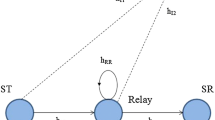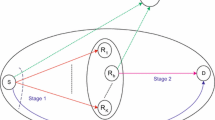Abstract
This paper evaluates the outage performance of cognitive relay networks with mutual interference between secondary users and primary users under the underlay approach, while adhering to the interference constraint on the primary user. A network path selection criterion, suitable for cognitive relay networks, is provided, from which we derive the outage probability expression of cognitive relay networks. It is shown that the outage probability considering the interference to secondary user from primary user is higher than that without considering the interference to secondary user from primary user. In addition, the outage probability is affected by key network parameters. We analyze network path selection method based on outage probability and prove that the interference to secondary user from primary user has a significant effect on the network path selection and can not be ignored in practical wireless communication environments. Simulation investigation is also provided and used to verify the theoretical analysis.







Similar content being viewed by others
References
Haykin, S. (2005). Cognitive radio: Brain-empowered wireless communications. IEEE Journal on Selected Areas in Communications, 23(2), 201–220.
Goldsmith, A., Jafar, S. A., Maric, I., & Srinivasa, S. (2009). Breaking spectrum gridlock with cognitive radios: An information theoretic perspective. Proceedings of the IEEE, 97(5), 894–914.
Wei, H. Y., & Gitlin, R. D. (2004). Two-hop-relay architecture for next generation WWAN/WLAN integration. IEEE Wireless Communications, 11(2), 24–30.
Hasna, M. O., & Alouini, M. S. (2003). End-to-end performance of transmission systems with relays over Rayleigh-fading channels. IEEE Transaction on Wireless Communications, 2(6), 1126–1131.
Laneman, J., Tse, D., & Wornell, G. (2004). Cooperative diversity in wireless networks: Efficient protocols and outage behavior. IEEE Transactions on Information Theory, 50(12), 3062–3080.
Cui, C. M., & Wang, Y. M. (2013). Analysis and optimization of sensing reliability for relay-based dual-stage collaborative spectrum sensing in cognitive radio networks. Wireless Personal Communications, 72, 2321–2337.
Bletsas, A., Khisti, A., Reed, D. P., & Lippman, A. (2006). A simple cooperative diversity method based on network path selection. IEEE Journal on Selected Areas in Communications, 24(3), 659–672.
Sreng, V., Yanikomeroglu, H. & Falconer, D. D. (2003). Relayer selection strategies in cellular networks with peer-to-peer relaying. In Proceedings of IEEE vehicular technology (pp. 1949–1953).
Muller, A. & Speidel, J. (2008). Relay selection in dual-hop transmission systems: selection strategies and performance results. In Proceedings of IEEE international conference communication (pp. 4998–5003).
Zhang, Q., Jia, J., & Zhang, J. (2009). Cooperative relay to improve diversity in cognitive radio networks. IEEE Communication Magazine, 47(2), 111–117.
Lee, K. & Yener, A. (2006). Outage performance of cognitive wireless relay networks. In Proceedings of IEEE global communication (pp. 1–5).
Suraweera, H. A., Smith, P. J. & Surobhi, N. A. (2008). Exact outage probability of cooperative diversity with opportunistic spectrum access. In Proceedings of IEEE international conference communication (pp. 79–84).
Mietzner, J., Lampe, L., & Schober, R. (2009). Distributed transmit power allocation for multihop cognitive-radio systems. IEEE Transactions on Wireless Communications, 8(10), 5187–5201.
Guo, Y., Kang, G., Zhang, N., Zhou, W., & Zhang, P. (2010). Outage performance of relay-assisted cognitive-radio system under spectrum-sharing constraints. IET Electronic Letter, 46(2), 182–184.
Yan, Z., Zhang, X. & Wang, W. (2011). Outage performance of relay assisted hybrid overlay/underlay cognitive radio systems. In Proceedings of IEEE WCNC (pp. 1920–1925).
Luo, L., Zhang, P., Zhang, G., & Qin, J. (2011). Outage performance for cognitive relay networks with underlay spectrum sharing. IEEE Communication Letter, 15(7), 710–712.
Lee, J., Wang, H., Andrews, J. G., & Hong, D. (2011). Outage probability of cognitive relay networks with interference constraints. IEEE Transactions on Wireless Communications, 10(2), 390–395.
Zhong, C., Ratnarajah, T., & Wong, K. (2011). Outage analysis of decode-and-forward cognitive dual-hop systems with the interference constraint in Nakagami-\(m \)fading channels. IEEE Transactions on Vehicular Technology, 60(6), 2875–2879.
Yan, Z., Zhang, X., & Wang, W. (2011). Exact outage performance of cognitive relay networks with maximum transmit power limits. IEEE Communication Letter, 15(12), 1317–1319.
Kim, J.-B., & Kim, D. (2012). Outage probability and achievable diversity order of opportunistic relaying in cognitive secondary radio networks. IEEE Transactions on Communications, 60(9), 2456–2466.
Khalife, H., Ahuja, S., Malouch, N. & Krunz, M. (2008). Probabilistic path selection in opportunistic cognitive radio networks. In IEEE global telecommunications conference, (pp. 1–5).
Pan, M., Yue, H., Zhang, C., & Fang, Y. G. (2013). Path selection under budget constraints in multihop cognitive radio networks. IEEE Transactions on Mobile Computing, 12(6), 1133–1145.
Xiang, X. T. & Wu, Q. H. (2009). Traffic driven based load balancing routing scheme in CogMesh network. In International conference on apperceiving computing and intelligence analysis (ICACIA) (pp. 198–202).
Mumey, B., Zhao, X., Tang, J. & Wolff, R. (2010). Transmission scheduling for routing paths in cognitive radio mesh networks. In The 7th annual IEEE communications society conference on sensor mesh and ad hoc communications and networks (SECON) (pp. 1–8).
Gradshteyn, I. S., & Ryzhik, I. M. (2000). Table of integrals, series, and products. San Diego: Academic Press.
Acknowledgments
The authors would like to thank Dr. Fengbin Sun for his help to improve this work. The work described in this paper was supported by National Natural Science Foundation of China (No. 61172056), Doctoral Fund of Ministry of Education of China (20093201110005) from Soochow University.
Author information
Authors and Affiliations
Corresponding author
Rights and permissions
About this article
Cite this article
Liu, S., Wang, Y. & Cui, C. Analysis of Network Path Selection Based on Outage Probability in Cognitive Relay Networks. Wireless Pers Commun 78, 1063–1078 (2014). https://doi.org/10.1007/s11277-014-1801-4
Published:
Issue Date:
DOI: https://doi.org/10.1007/s11277-014-1801-4




